
While in Bergen to lecture at the university I came across a couple of signs that begged to be photographed. It seems like kebab and pizza are always together here, even under the mantra of nirvana.

While in Bergen to lecture at the university I came across a couple of signs that begged to be photographed. It seems like kebab and pizza are always together here, even under the mantra of nirvana.
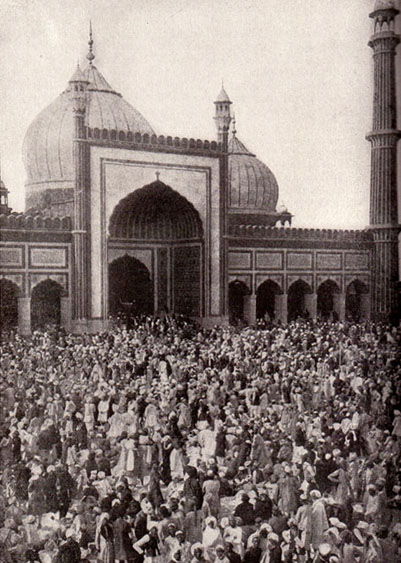
“The Jama Masjid at Delhi, India. This is India’s greatest mosque and is the second largest in the world. It was built by Shah Jehan in the first part of the seventeenth century and possessed a sacred relic, a hair from the beard of the prophet. The illustration shows a crowd in the court and which is 325 feet square, dispersing after meeting at prayers.”
Exactly 90 years ago a four-volume set of encyclopedia-like human interest books was published as The Human Interest Library: Visualized Knowledge by Midland Press in Chicago. In a previous post I commented on its thoroughly “Orientalist” flavor. The section on “The Ancient Empire of the Moguls” covers mainly the exotic cultural diversity of India. Few countries have been exoticized more than India, and this Cyclopedia is not exception:
How may be described this soul of India: It is something shy, timorous, wistful and appealing. It does not greet you with the rugged strength and boisterous self-confidence of Dover Cliff, or with the passionate sweetness of Italian hills, or with the sunburnt cheerfulness of France. It creeps towards you like a spaniel that fears to be scolded and hopes to be caressed. Continue reading Old World Travel 90 years on: #5 The Soul of India
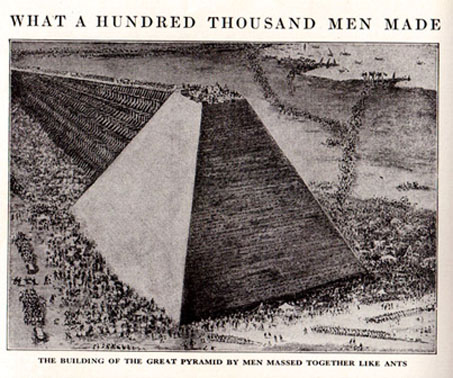
Exactly 90 years ago a four-volume set of encyclopedia-like human interest books was published as The Human Interest Library: Visualized Knowledge by Midland Press in Chicago. In a previous post I commented on its thoroughly “Orientalist” flavor. The section on Egypt covers mainly the archaeological history with only a few brief comments on the then contemporary state of Egypt. One of the great mysteries over the years has been an explanation for how the massive pyramids were built. Here is a novel idea, if a picture is worth a thousand scholarly words: ants.

A History of the Church, p. 95
One of the books owned by a great, great aunt of mine in Cleveland was A History of the Church, etc., published in 1833. In a previous post, I offered some excerpts from its coverage of “Mahometanism.” The author is a certain C. A. Goodrich, who is decidedly Protestant and as unfriendly to Roman Catholicism as he is to Islam and Hinduism. Near the end of the book is a section entitled “The Story of the World” by Josiah Conder, originally published in the Missionary Annual for 1833. Its comments on the various religions, including Islam, is quite fascinating, again as a reflection of a time when the United States was barely half a century old. Continue reading On Mahometism, 1833 style: #2
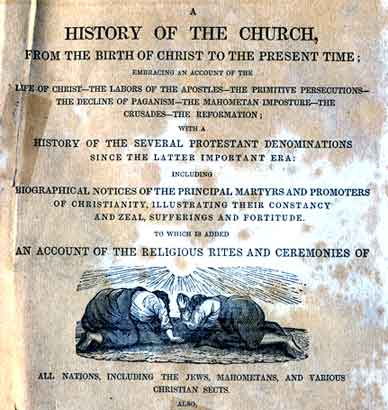
One of the books owned by a great, great aunt of mine in Cleveland was A History of the Church, etc., published in 1833. The bottom of the frontispiece is torn, so I do not know the publisher, although I suspect it was printed in Boston. It is a general history of Christianity with extended comments on other religions, including “Mahometanism.” The author is a certain C. A. Goodrich, who is decidedly Protestant and as unfriendly to Roman Catholicism as he is to Islam and Hinduism. Several parts of the text, which stretches a robust 504 pages, deal with Islam and are interesting for the biased perspective of the time. The history of the Church is according to periods, and Period V is labeled “The Rise of Mahometanism” (at the top of the pages of the chapter); the longer title is “The Period of the Rise of the Mahometan Imposture will extend from the establishment of the supremacy of the Roman Pontiffs, A.D. 606, to the first Crusade, A. D. 1095.” Period VI covers the Crusades, followed by the Reformation and then a very long chapter on the Puritans.
At the start of the section is a small lithograph of Muhammad, mounted on a steed with a sword in hand. Some of the information is descriptive; some even praises Muhammad, but it is clear that the author despises Islam as the excerpts below well show:
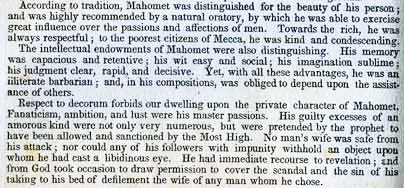
A History of the Church, 1833, p. 96
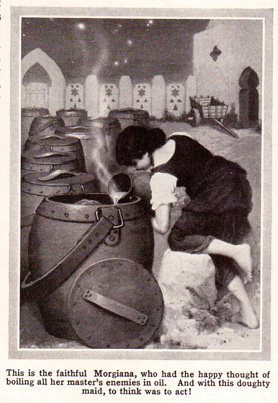
[With this post I continue a series dedicated to photographs in an “Orientalist” mode. In addition to Reading Orientalism (which is also the title of my last book), the creation of an imagined Orient is very much a pictorial voyeuristic voyage. In this series I focus on Western images of the Middle East and North Africa, both those that perpetuate stereotypes and those that chip away at the bias. Readers of the blog are welcome to send in images they have found and want to share.]
I continue with images from a 1933 edition of Richards Cyclopedia, with 24 volumes published in New York by J. A. Richards, Inc and edited by Ernest Hunter Wright and Mary Heritage Wright. This is an unusual encyclopedia, arranged by topics in a more or less arbitrary order but replete with images. One of the articles is called “The Mtchless Story-Teller” (vol 18, pp. 4433-4448) and retells several of the more famous tales from the Arabian Nights. In the story of Ali Baba and the Forty Thieves the plot to learn the secret of the cave from Ali Baba unfolds with a slave girl named Morgiana pouring hot oil in the vats where a number of robbers were hiding. But the reader is assured in the caption that it was a “happy thought” to so dispense with the troublemakers. Ah, how Orientalist to assume this part of the world has oil to burn…
to be continued
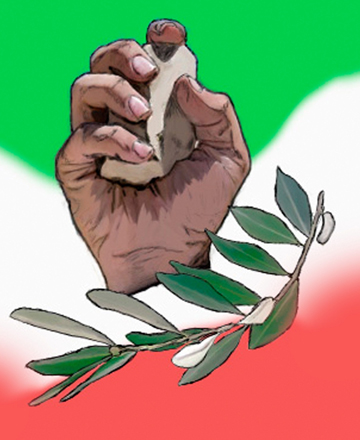
By Andreas Neumann, Erlangen Center for Islam & Law in Europe (EZIRE)
Recently, at one of the many German universities of excellence (names do not matter), students and other citizens were invited to a lecture with the title: “Stoning: a Non-Islamic tradition.†The hosts were the Seminar for Arab and Islamic Studies and the Institute of Criminal Sciences. The picture represented here is taken from the poster hanging all over the campus and also in the city. At its center, you see a huge hand on the point of casting a crude edged stone in the direction of the observer. In the foreground, there is an olive branch. The colors in the background evoke the national flag of Iran flying in wind. A short analysis might be fruitful. The picture is an example of contemporaneous stereotyped thinking and also transports a message contrary to the requirements of reason.
The hand, disambiguated by the context, symbolizes the gruesome act. It is combined with the enlarged olive branch. The olive branch was a symbol of peace in Greek and Roman antiquity, when it also was worn as an adornment by brides. Retrospectively, it was associated with Noah who sent out a dove which returned with an olive leaf in its beak (which became a branch in the Vulgate). This sign indicated that the water was receding. There might exist an older model of this image, since the association of the dove, the olive branch or even the rainbow with peace does not follow conclusively from the text. The Quran has not taken it over in its frequent references to the Genesis version of the story of the Flood (also see the account by Heinrich Speyer, Die biblischen Erzählungen im Qoran, Gräfenhainichen 1931, pp. 89-115). Nevertheless, the olive tree (by the way, in German more often called “Ölbaumâ€, oil tree) is cited several times in the Quran, especially in the beautiful verse of the light, Q 24:35, where the blessed olive tree in question is characterized as neither Eastern nor Western (cf. Zechariah 4:3-11). The olive branch has become an international symbol of peace and is represented on the emblem of the United Nations, where two of them symmetrically embrace a map of the world. Continue reading New Orientalism at a German University?
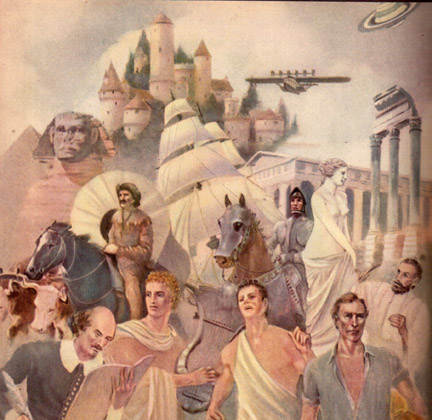
Half of the painting for the inside cover of Richards Cyclopedia, by Edwin Winfield Hall
[With this post I continue a series dedicated to photographs in an “Orientalist” mode. In addition to Reading Orientalism, the title of my last book, the creation of an imagined Orient is very much a pictorial voyeuristic voyage. In this series I focus on Western images of the Middle East and North Africa, both those that perpetuate stereotypes and those that chip away at the bias. Readers of the blog are welcome to send in images they have found and want to share.]
I continue with an image from a 1933 edition of Richards Cyclopedia, with 24 volumes published in New York by J. A. Richards, Inc and edited by Ernest Hunter Wright and Mary Heritage Wright. This is an unusual encyclopedia, arranged by topics in a more or less arbitrary order but replete with images. The inside cover, half of which is shown above, is a collage of cultural references. Across the top one finds the beginnings of civilization (at least in the thinking of the time) in the ancient Egyptian pyramid and sphinx, with a towering medieval castle above and both a modern airplane and image of Saturn looking down on ancient Greece, where a beautiful half-naked Grecian standing odalisque butts up against a knight in shining armor. There are ships and covered wagons in this pictorial representation of manifest destiny. The part not shown is distinctively American progress, though with a Maharajah inexplicably riding an elephant in front of a giant oceanliner. Continue reading Orientalist Images #2